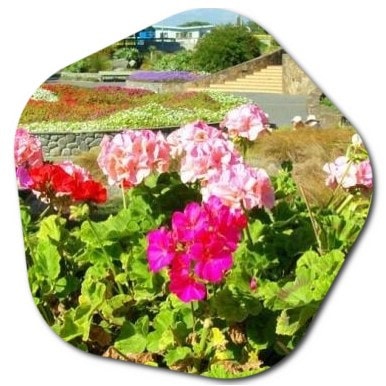How to landscape a garden in Birmingham?
The width and length of the garden, the distance of the borders to the building, other structures and trees, if any, should be indicated on the sketch. On the sketch, wind corridors, sunshade and shade areas, building entrance, road, if any, bad images we want to hide, noise centers, scenic direction we want to see, etc. should be indicated.
Landscaping a garden in Birmingham, Alabama, involves creating an outdoor space that not only enhances the aesthetics of your property but also takes into account the local climate and conditions. Landscaping in Birmingham can take different forms depending on the soil structure of your garden, its size and the plan to be made. We will give you some suggestions for landscaping in your area.
Here are step-by-step guidelines for landscaping your garden in Birmingham:
1. Define Your Goals and Budget:
- Determine your landscaping goals, whether it’s creating a relaxing retreat, a vibrant garden, or an entertainment area.
- Establish a budget to guide your project.
2. Site Analysis:
- Evaluate your garden’s existing conditions, including soil quality, drainage, sunlight, and microclimates.
3. Landscape Design:
- Create a detailed landscape plan that includes the layout of plants, hardscape features (paths, patios, etc.), and any additional elements like water features or outdoor lighting.
- Consider using native and drought-resistant plants to reduce water usage and maintenance.
4. Soil Preparation:
- Test and amend the soil as necessary to ensure it provides the right nutrients and drainage for your chosen plants.
5. Plant Selection:
- Choose plants that thrive in Birmingham’s climate, which includes hot summers and mild winters.
- Include a mix of trees, shrubs, perennials, and annuals for year-round interest.
6. Hardscape Elements:
- Incorporate hardscape elements such as pathways, patios, and retaining walls that complement your garden design.
- Use materials that withstand Birmingham’s weather conditions.
7. Irrigation System:
- Install an efficient irrigation system that ensures proper watering while conserving water.
- Consider drip irrigation for precise watering of plants.
8. Planting:
- Plant trees and shrubs in the fall or early spring when temperatures are milder.
- Follow proper planting techniques, including digging adequate planting holes and providing mulch.
9. Mulching:
- Apply mulch around plants to retain moisture, suppress weeds, and regulate soil temperature.
10. Maintenance Plan:
– Develop a maintenance plan that includes regular watering, pruning, fertilizing, and weeding.
– Adjust your maintenance practices based on the seasons.
11. Lighting:
– Add landscape lighting to enhance the garden’s beauty and safety at night.
– Use energy-efficient LED lighting for cost savings.
12. Sustainable Practices:
– Embrace sustainable landscaping practices such as xeriscaping, which reduces water usage, and using native plants to support local wildlife.
– Consider installing rain barrels to collect rainwater for irrigation.
13. Compliance with Local Regulations:
– Ensure that your landscaping project complies with local regulations, including permits and zoning requirements.
14. Professional Help:
– For complex projects, consider hiring a professional landscape designer or contractor with experience in Birmingham’s climate.
15. Enjoy and Adapt:
– Finally, enjoy your newly landscaped garden and be prepared to adapt and make changes as needed based on how the garden evolves over time.

By following these steps and considering Birmingham’s specific climate and conditions, you can create a beautiful and sustainable garden that thrives in this region of Alabama.
Plants suitable for landscaping in Birmingham
Landscaping in Birmingham, Alabama, benefits from selecting plants that thrive in the city’s climate, characterized by hot, humid summers and mild winters. Here are some plant options suitable for landscaping in Birmingham:
1. Trees:
- Southern Magnolia (Magnolia grandiflora): Known for its large, glossy leaves and fragrant white flowers.
- Crape Myrtle (Lagerstroemia indica): Offers vibrant summer blooms in various colors.
- Live Oak (Quercus virginiana): An iconic Southern tree with evergreen foliage.
- Red Maple (Acer rubrum): Provides brilliant fall foliage and adaptability to wetter soils.
- Bald Cypress (Taxodium distichum): A unique deciduous conifer with attractive foliage and bark.
2. Shrubs:
- Azalea (Rhododendron spp.): Known for spring blooms in various colors.
- Camellia (Camellia spp.): Offers beautiful winter and early spring flowers.
- Hydrangea (Hydrangea spp.): Known for large, colorful flower clusters.
- Abelia (Abelia spp.): Features fragrant flowers and attractive foliage.
- Nandina (Nandina domestica): Offers year-round interest with colorful foliage.
3. Perennials:
- Daylilies (Hemerocallis spp.): Available in various colors and easy to grow.
- Salvia (Salvia spp.): Provides long-lasting, vibrant blooms.
- Hosta (Hosta spp.): Ideal for shaded areas with attractive foliage.
- Coreopsis (Coreopsis spp.): Drought-tolerant perennials with cheerful flowers.
- Coneflower (Echinacea purpurea): A native perennial with striking purple or pink flowers.
4. Annuals:
- Marigold (Tagetes spp.): Vibrant and easy-to-grow annuals with pest-repelling properties.
- Zinnia (Zinnia spp.): Heat-tolerant annuals with colorful, daisy-like blooms.
- Impatiens (Impatiens walleriana): Shade-loving annuals with striking flowers.
- Petunia (Petunia spp.): Available in various colors, providing continuous summer color.
- Coleus (Plectranthus scutellarioides): Grown for its colorful foliage.
5. Vines and Groundcovers:
- Confederate Jasmine (Trachelospermum jasminoides): Features fragrant white flowers and is ideal for trellises.
- Carolina Jessamine (Gelsemium sempervirens): Offers bright yellow, trumpet-shaped flowers.
- Vinca (Catharanthus roseus): Heat and drought-tolerant groundcover with attractive flowers.
6. Herbs and Vegetables:
- Basil (Ocimum basilicum): Aromatic and useful in the kitchen.
- Tomatoes (Solanum lycopersicum): Well-suited for summer vegetable gardening.
- Peppers (Capsicum spp.): Various varieties, including sweet and hot peppers.
- Okra (Abelmoschus esculentus): Thrives in hot summers and provides edible pods.
- Rosemary (Rosmarinus officinalis): Drought-tolerant herb with aromatic foliage.

When landscaping in Birmingham, consider the specific sunlight, soil, and water conditions of your garden area, as well as your design preferences, to choose the best plants for your landscape. Native and drought-resistant species are often excellent choices for sustainable and low-maintenance landscaping in this region.





